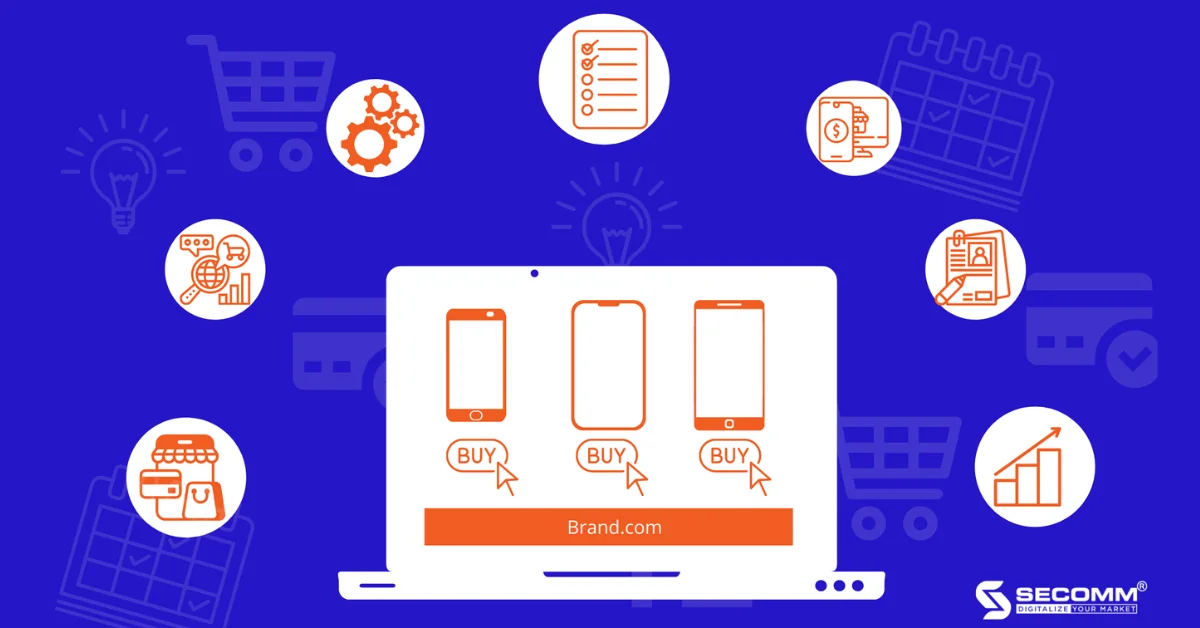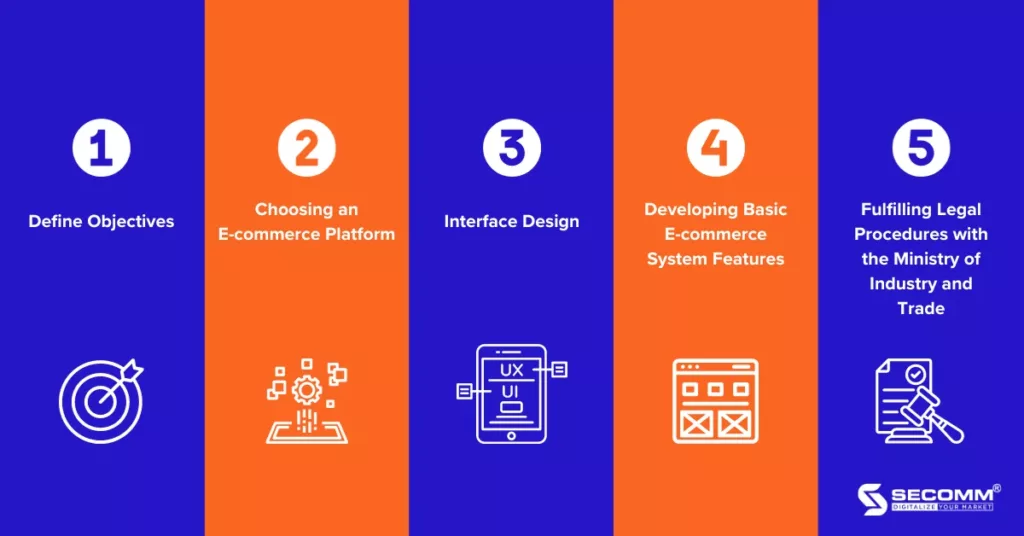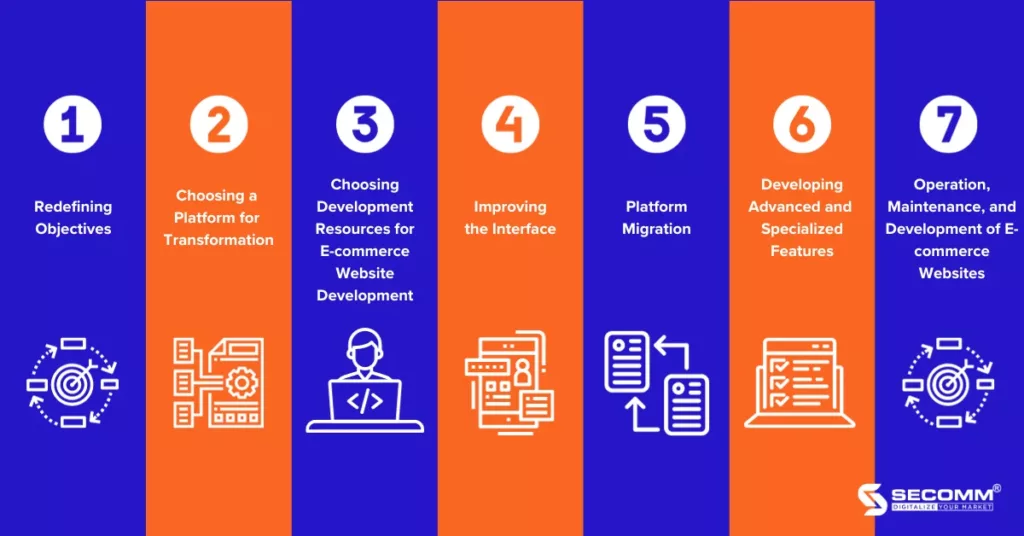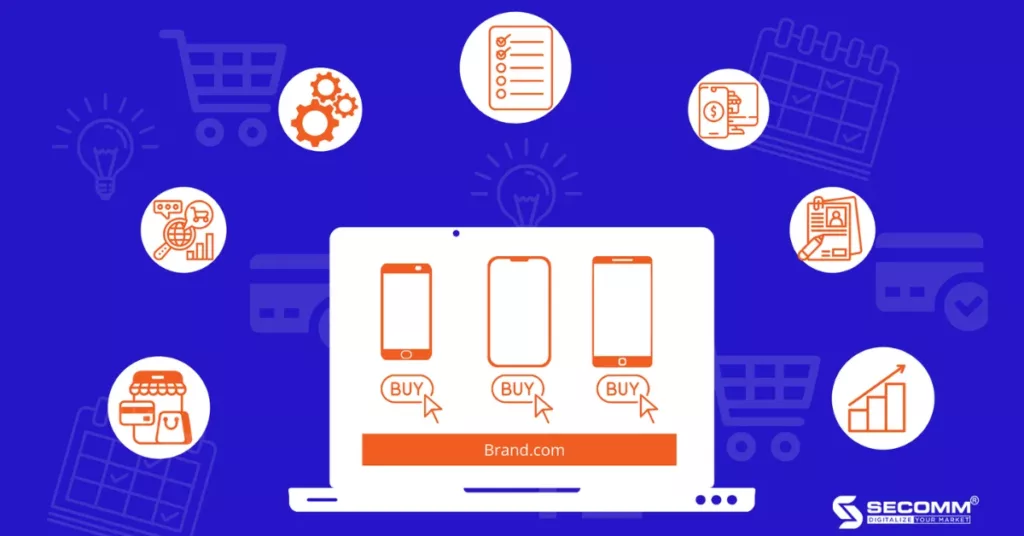It seems we can’t find what you’re looking for. Perhaps searching can help.
Sign Up for newsletter!
Subscribe to get the latest eBook!
Hotline







The COVID-19 pandemic has shifted shopping trends from traditional stores to online channels. Due to the pandemic, the demand for electronic products such as phones, laptops, and tablets has increased. This has helped mobile phone retail businesses achieve high revenue growth and profitability.
The “leap” into e-commerce has opened up many opportunities for businesses to develop – opportunities to provide a fast and seamless shopping experience for customers, expand sales channels, increase revenue, and establish brand identity.
In this context, owning an e-commerce website is almost a prerequisite for starting a successful online business. An e-commerce website can support businesses in several ways:
Related article: Top 10 retail websites for mobile phones in Vietnam
Though the benefits are plentiful, how can one design a comprehensive e-commerce website for a business professionally and effectively?
Below is the journey to build a comprehensive e-commerce website for a mobile phone retail business with two main stages: (1) building the basic e-commerce website and (2) transitioning to building an in-depth e-commerce website.

The first step in constructing an e-commerce website is for the business to determine elements such as objectives, budget, and time for project development.
After completing the “ideation” for the e-commerce website, businesses can kickstart the project by purchasing suitable hosting and domain names aligned with the products or services the business intends to offer.
Once the specific business strategy has been identified, the business needs to carefully consider choosing a platform for building the e-commerce website. Currently, the two most popular types of e-commerce platforms are Software as a Service (SaaS) and open-source platforms.
With SaaS platforms, businesses can choose from various pre-designed templates and features to build a website through simple drag-and-drop operations, requiring minimal investment in terms of time and development costs. However, with SaaS platforms, businesses do not own the source code and data; they can only utilize the available features of the platform. The flexibility and scalability of the system are limited, and usage costs may increase over time. Some popular SaaS platforms in Vietnam include Haravan, Shopify, Sapo, etc.
With open-source platforms, businesses have complete freedom to design the interface according to their requirements. These platforms offer high flexibility and can be customized extensively. Open-source platforms provide a full range of features and additional utilities, supporting sustainable development. Businesses own all the source code and data. However, businesses will need a skilled in-house team or experienced development partners to accompany them, investing time and money in development. Some popular open-source platforms include Magento, WooCommerce, OpenCart, etc.
Businesses can initiate the interface design for the website on the selected platform by using existing templates or themes available on the system. Alternatively, they can customize and design a unique interface that aligns with the brand image and specific preferences of the mobile phone retail industry.
At this stage, the business collaborates with an in-house IT team or a deployment unit to establish fundamental eCommerce features, ensuring smooth sales processes on the system. On both SaaS and open-source platforms mentioned earlier, businesses can choose suitable functions and integrate them into the website. Some common basic features include:
A mandatory criterion for the official operation of a business’s eCommerce website is the completion of legal documents following regulations. According to Decree 52/2013/ND-CP by the Government, individuals or organizations owning eCommerce websites for selling goods are required to notify or register with the Ministry of Industry and Trade on the eCommerce Management Portal.
Businesses can either complete the registration process themselves or enlist the services of law firms that provide related services.
Typically, a basic website may only support a business in its initial stages and face challenges as the business model evolves. Businesses gradually realize the need to develop a more specialized eCommerce system to enhance service quality and improve the overall experience for both customers and the business itself. The development of a sophisticated system requires businesses to be more prepared in terms of time and costs compared to the initial phase.

Similar to developing a basic eCommerce system, the first step in developing a sophisticated e-commerce website is for the business to redefine its objectives, costs, and timelines for the project. It is crucial to explore specific features and advancements within the industry. This allows the business to plan a detailed and accurate development strategy that aligns with its business model.
To develop a deep eCommerce system, businesses should opt for open-source platforms such as Magento, WooCommerce, OpenCart, etc. Open-source platforms can best meet the expanding system needs and sustain development alongside the business. However, besides the drawbacks of high development costs and an extended construction period, businesses also need an experienced IT team to effectively utilize these platforms.
Criteria for Platform Selection at This Stage:
Allows the development of a standardised user interface that reflects the brand’s characteristics and showcases product images clearly and cohesively.
Enhances brand identity and differentiation.
The admin interface should be user-friendly, facilitating easy navigation, control, and management of the entire system’s data.
The system should support basic functions and be flexible enough to accommodate the development or integration of advanced and specific features.
This flexibility ensures stable business operations in the long term and the ability to adapt to evolving business models.
Seamless integration with other software without compromising the performance of individual systems.
High scalability to adapt and grow alongside the business, catering to various business models.
Cost-effective long-term budgeting while constructing a sustainable and efficient system suitable for the business.
The ability to expand, whether it’s adding multiple websites, operating in multiple countries, dealing with various currencies, or managing multiple channels.
Ensures the system can efficiently meet the evolving needs of the business.
Can extend to multiple websites, support internationalisation, handle diverse currencies, and manage various sales channels.
Ensures stable system operation regardless of increasing web traffic and transaction volumes over time.
To build a sophisticated eCommerce website, businesses can either establish an in-house team or collaborate with external development partners. In both cases, a skilled and experienced workforce with a professional work ethic is essential.
In-House Team:
External Development Partners:
Recommended Service Providers: Several service providers specialize in deploying advanced eCommerce systems. Some notable examples include SECOMM, SmartOSC, Co-Well Asia, Isobar, and Magenest.
Choosing between an in-house team and external partners depends on the business’s specific needs, resources, and preferences. Each option has its advantages and challenges, and businesses must carefully evaluate their circumstances before making a decision.
While transitioning to a new eCommerce platform, businesses have the flexibility to retain their current website interface or redesign it for an enhanced user experience and improved brand positioning. Redesigning involves adjusting existing themes to save time and budget. However, some businesses opt for a custom redesign to meticulously tailor the interface to their specific needs, which may require a higher investment in terms of time and budget.
Platform migration is a crucial step in building a deep eCommerce website. Automation is typically used to minimize errors during the transition. Businesses need a comprehensive plan encompassing features, data, and scenarios to ensure a smooth and effective transition. The process begins with data extraction from the old system and recording it into the new system.
Post-migration, thorough testing is essential to verify that all components and data have been accurately and adequately transferred according to the plan.
When constructing a deep eCommerce website, businesses must introduce advanced and specialized features to support business model expansion, enhance competitiveness, adapt to market changes, increase revenue, and improve the shopping experience. Some advanced features for eCommerce and mobile retail may include Buy Now Pay Later, Flash Sales, and advanced product search functionalities.
Continuous learning and staying informed about necessary features are crucial for system development. This can be achieved through online applications, an in-house development team, or external development experts. After outlining the development plan, collaboration with design experts to create a system model is essential. The subsequent step involves programming features based on the approved plan. Before deployment, thorough testing, based on the requirements specification document, is conducted to update test scenarios and log errors using error management tools.
After developing an eCommerce website, regular maintenance, care, and updates are necessary to ensure continuous online business operation, seamless system operation from online to offline, and optimal user satisfaction. Ongoing research is vital to optimize and develop the website to create a satisfying and comfortable shopping experience.

In summary, a comprehensive eCommerce website is crucial for the current and future success of mobile phone retail businesses. Building such a website involves a meticulous process, and each step is critical. Businesses can contact SECOMM for free consultations on comprehensive eCommerce website solutions tailored to mobile phone retail businesses.
 2
2
 12,112
12,112
 0
0
 1
1Subscribe to get the latest eBook!
Hotline